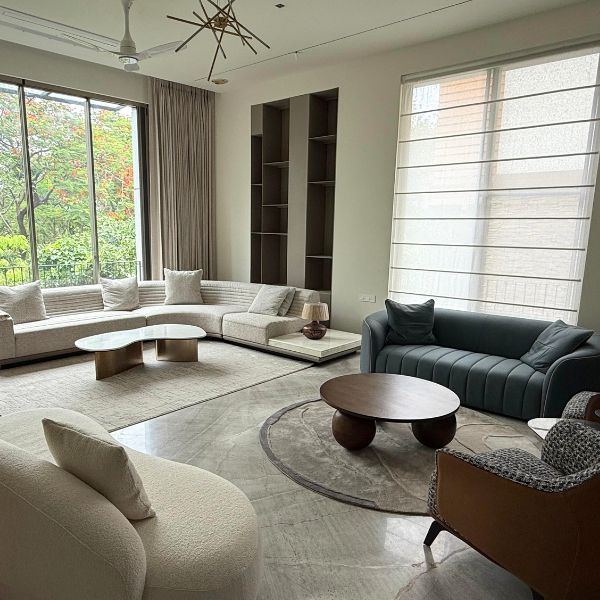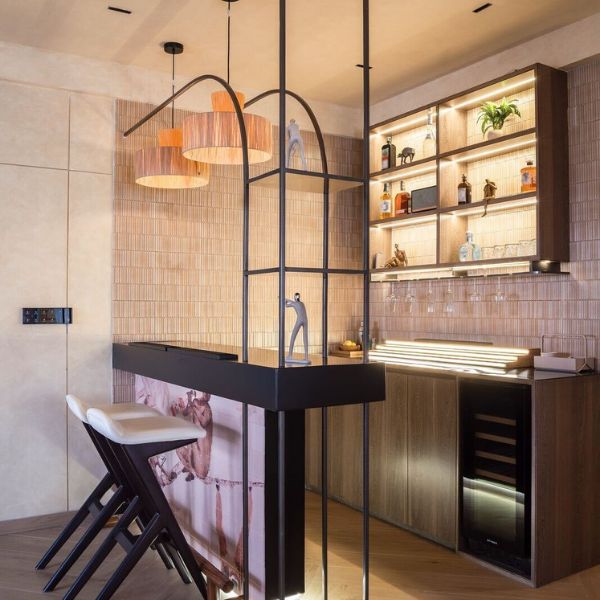Elara Boucle Comfortable Armchair | Wooden Cushion Chair for Living Room | Lounge Chair
Rhea Boucle Armchair for Living Room & Wooden Cushion Chair with Arms
Aesthetic Rattan Pendant Wave Lampshade | Decorative Hanging Light For Living Room & Home
Contemporary Bohemian Style Single Ceiling Hanging Light Lamp For Home Decor
Lush Bloom String Light
Aesthetic Oval Rattan Hanging Lantern | Natural & Black Tealight Candle Holder For Home Decor
Twilight Floor Lamp | Bedroom Floor Lamps | Designer Standing Lamps for Living Room
Bamboo & Brass Finished Metamorphosis Pendant Lamp | Hanging Light For Living Room & Home
Bamboo & Linen Fabric Lotus Hanging Pendant Lamp | Ceiling Light For Living Room & Outdoor
Cushion Covers | Texture Pillow cover
Handwoven Wicker Peony Basket | Storage Unit For Home Organizer
Natural Wood & Jute Table Lamp | Home Decor Lamp | Table Lamps for Living Room
Floor Lamps with Shelve for Living Room | Floor Lampshades
Jute Mesh Up TV Cabinet with Natural Jute | Modern TV Unit & TV Stand
Bamboo Wooden & Steel Console TV Cabinet For Living Room & Home
Bohemian Glow: Fringed Munja Hay 14 inch Pendant Light Adds Rustic Charm & Modern Flair
Floor Lamps With Shelve | stand lamp light For Living Room
Floor Lamps With Shelve | Storage floor lamps For Living Room
Column Floor Lamps | Standing Lamp For Living Room
Natural | Wooden Column Floor Lamps
Get a glimpse of how our products look in real spaces
Create a Calming Japandi Bedroom at IKIRU: A Perfect Blend of Minimalism & Warmth
Japandi interior design is an especially great style for the bedroom, as the calming elements of nature and clean lines help the body relax after a long day or wake up peacefully, even in times of stress. Both Japanese and Scandinavian cultures deeply respect the home, viewing it as a sanctuary designed to nourish the soul. Given that we spend nearly a third of our lives sleeping, crafting a space that nurtures both body and mind is a worthwhile investment.
We've compiled some of our favourite Japandi bedroom design ideas below to inspire you. See if this trend aligns with your vision for a restful, stylish space.
What Defines Japandi Style?
Japandi style is a fusion of Japanese interior and Scandinavian coziness, emphasizing function, natural elements, and intentional design. It balances clean, uncluttered spaces with warm textures and earthy tones, creating a harmonious and inviting atmosphere.
Japandi Bedroom Essentials
-
A Low-Profile Bed for Grounded Serenity
Inspired by traditional Japanese furniture, such as futons and Scandinavian simplicity, a platform or floor bed enhances a sense of calm and connection to nature. This style keeps the bed visually unobtrusive, making the space feel open and airy. Opt for beds crafted from natural wood with a minimalist frame to maintain the Japandi aesthetic. -
Neutral & Earthy Color Palette
Soft neutrals like warm whites, muted greys, beige, and earthy browns create a soothing ambiance. These colors provide a perfect backdrop for layering different textures and materials while maintaining a tranquil and cohesive look. Accents in muted greens or deep blues can be subtly introduced to mimic natural elements and align with Japanese home decor. -
Functional, Minimal Furniture
Japandi bedrooms prioritize quality over quantity. Every piece of furniture should have a purpose while maintaining a clean and simple design. Choose well crafted wooden furniture with simple silhouettes, such as oak or ash bedside tables, dressers, and chairs. If you're looking for Japanese furniture in India, opt for pieces that reflect both aesthetics and functional yet elegant. Storage solutions should be sleek and practical, ensuring a clutter-free environment. -
Layered Textures for Warmth
While minimal, Japandi isn’t cold. A key element of this style is layering soft and natural textiles to add warmth and coziness. Incorporate linen bedding, wool throws, and woven rugs to create a tactile contrast against sleek wooden furniture. These elements contribute to a Japanese home interior that feels comfortable and welcoming. -
Nature-Inspired Accents
Bring the outdoors in with potted plants, bamboo decor, or ceramic vases. These elements reflect wabi-sabi (the beauty of imperfection) and hygge (cozy comfort), core principles of Japandi design. Low-maintenance plants like bonsai, snake plants, or pampas grass add a refreshing touch while maintaining the minimalist aesthetic often seen in Japanese house interiors. -
Soft, Natural Lighting
Lighting plays a crucial role in Japandi aesthetics, as it helps set the mood for relaxation. Opt for warm-toned, indirect lighting through paper lanterns, linen-covered lamps, or minimalist pendant lights. Floor lamps with wooden bases and rice paper shades can add a soft glow, enhancing the cozy yet airy feel of the bedroom, a key feature of Japanese home design. Adding stylish side tables can further enhance the functionality and aesthetics of the space. -
Thoughtfully Chosen Decor Pieces
Japandi style avoids excessive decor but embraces meaningful, high-quality pieces. Consider handcrafted ceramics, textured cushions, and subtle artwork that complements the earthy color palette. Every decor element should contribute to the tranquil atmosphere of a Japanese home interior. -
The Role of Furniture in Japandi bedroom
The right furniture pieces are crucial in bringing together the Japandi aesthetic. Consider adding:-
Side Tables: Simple, wooden, and functional, they provide space for lamps, books, or a cup of tea while keeping the area clutter-free.
-
Chairs & Seating: Low, comfortable seating like lounge chairs or floor cushions blend with the Japandi aesthetic, offering both style and practicality.
-
Storage Solutions: Wooden dressers, open shelving, and discreet storage solutions keep the space organized and maintain the minimalist aesthetic.
-
Lighting Fixtures: Pendant lights, floor lamps, and bedside table lamps with linen or rice paper shades create a soft, ambient glow that enhances relaxation.
-
Why Choose Japandi for Your Bedroom?
-
Encourages Mindful Living – Japandi spaces promote intentionality, reducing clutter and enhancing well-being.
-
Creates a Relaxing Atmosphere – The combination of natural materials and muted tones fosters a serene environment.
-
Timeless & Versatile – Japandi isn’t just a fleeting trend; its blend of form and function makes it an enduring style.
-
Sustainable & Eco-Friendly – With a focus on natural materials and quality craftsmanship, Japandi interiors align with a sustainable lifestyle.
How to Incorporate Japandi in Your Bedroom?
If you're looking to introduce the Japandi style into your bedroom, here’s how you can do it effortlessly:
-
Start with a Minimalist Layout: Remove excess furniture and keep only what is essential.
-
Select Natural Wood Furniture: Choose light or dark wood tones to create contrast while maintaining warmth.
-
Incorporate Cozy Textiles: Linen curtains, cotton bedspreads, and wool rugs can add layers without feeling heavy.
-
Use Subtle Japanese-Inspired Decor: Handmade ceramics, bamboo trays, and rattan baskets bring authenticity to the space.
-
Add Indoor Plants: Greenery enhances tranquility and freshness, making your space more inviting.
-
Opt for Warm, Layered Lighting: Balance natural light with soft indoor lighting to create a peaceful environment.
Transform Your Bedroom with Japandi-Inspired Pieces
If you're drawn to the balance of simplicity and warmth, Japandi might be the perfect style for your bedroom. Whether you're looking for Japanese furniture, decor, or inspiration for Japanese home interior design, this style offers a perfect blend of function and beauty. Explore Ikiru’s collection of thoughtfully designed furniture and decor—including lights, side tables, chairs, and plants—to bring this trend to life in your space.
Start curating your peaceful retreat today!
FAQs
1. What is Japandi decor?
Japandi is a design style that blends Japanese minimalism and Scandinavian functionality. It focuses on creating serene, peaceful spaces using a balance of simple forms, natural materials, neutral tones, and clean lines. The goal is to merge the beauty of Japanese craftsmanship with the practicality of Scandinavian design.
2. What are the key elements of Japandi decor?
Minimalism: Clean, clutter-free spaces with carefully curated pieces.
Natural materials: Wood, stone, and bamboo are commonly used.
Neutral colors: Soft shades of beige, gray, white, and muted tones.
Functional furniture: Simple and elegant pieces with practical purposes.
Organic shapes: Curved furniture and soft textures.
Indoor plants: To bring nature indoors and promote calm.
3. How can I achieve a Japandi look in my home?
Start with a neutral color palette for walls and larger furniture pieces.
Choose wooden furniture with simple, clean lines.
Keep decorations minimal—add items like bonsai trees, handmade ceramics, and natural textiles. Use soft lighting, like paper lanterns or Scandinavian-style lamps.
Opt for functional, space-saving furniture that has an aesthetic appeal.
4. Is Japandi decor suitable for small spaces?
Yes! Japandi is perfect for smaller spaces because of its minimalist nature. The design focuses on decluttering and using functional, space-saving furniture, creating a calming, open environment. Light colors and natural materials can also help make a room feel more expansive.
5. What types of furniture are best for a Japandi style?
Look for low-profile, functional pieces with clean lines and minimal ornamentation. Furniture made from wood, like low-sitting sofas, coffee tables, and bookshelves, is ideal. Scandinavian-style chairs and simple tatami mats also fit well into Japandi interiors.
6. What colors are commonly used in Japandi decor?
Japandi typically features muted and neutral tones like white, gray, beige, and soft browns. Accent colors, such as dark green, navy, or earthy tones, may be used sparingly to add depth to the design.
7. What is the role of lighting in Japandi design?
Lighting plays a critical role in creating a peaceful, warm atmosphere. Use soft, ambient lighting such as paper lanterns, simple pendant lights, or Scandinavian-style fixtures. Avoid harsh, bright lights—opt for dimmable and warm-toned lights to enhance relaxation.
8. What are some common mistakes to avoid when decorating in Japandi style?
Overcrowding the space with too many items or furniture pieces.
Using too many contrasting colors or bold patterns—Japandi thrives on subtlety.
Neglecting functionality—every piece should serve a purpose.
Forgetting the importance of natural light—Japandi spaces often embrace natural light to enhance the serene atmosphere.
9. What is Japandi style?
Japandi style combines Japanese and Scandinavian design concepts, focusing on simplicity, minimalism, natural materials, and the creation of serene and practical spaces.
10. Can Japandi style work in small spaces?
Certainly! Japandi style is ideal for small areas as it emphasizes uncluttered design and efficient space utilization.
11. Can Japandi style be combined with other design themes?
Yes, Japandi style can be mixed with other design themes to create a unique and personal look.
12. Is Japandi outdoor furniture durable for various weather conditions?
Japandi outdoor furniture is designed to withstand various weather conditions while maintaining style and resilience.











































































